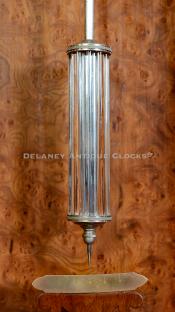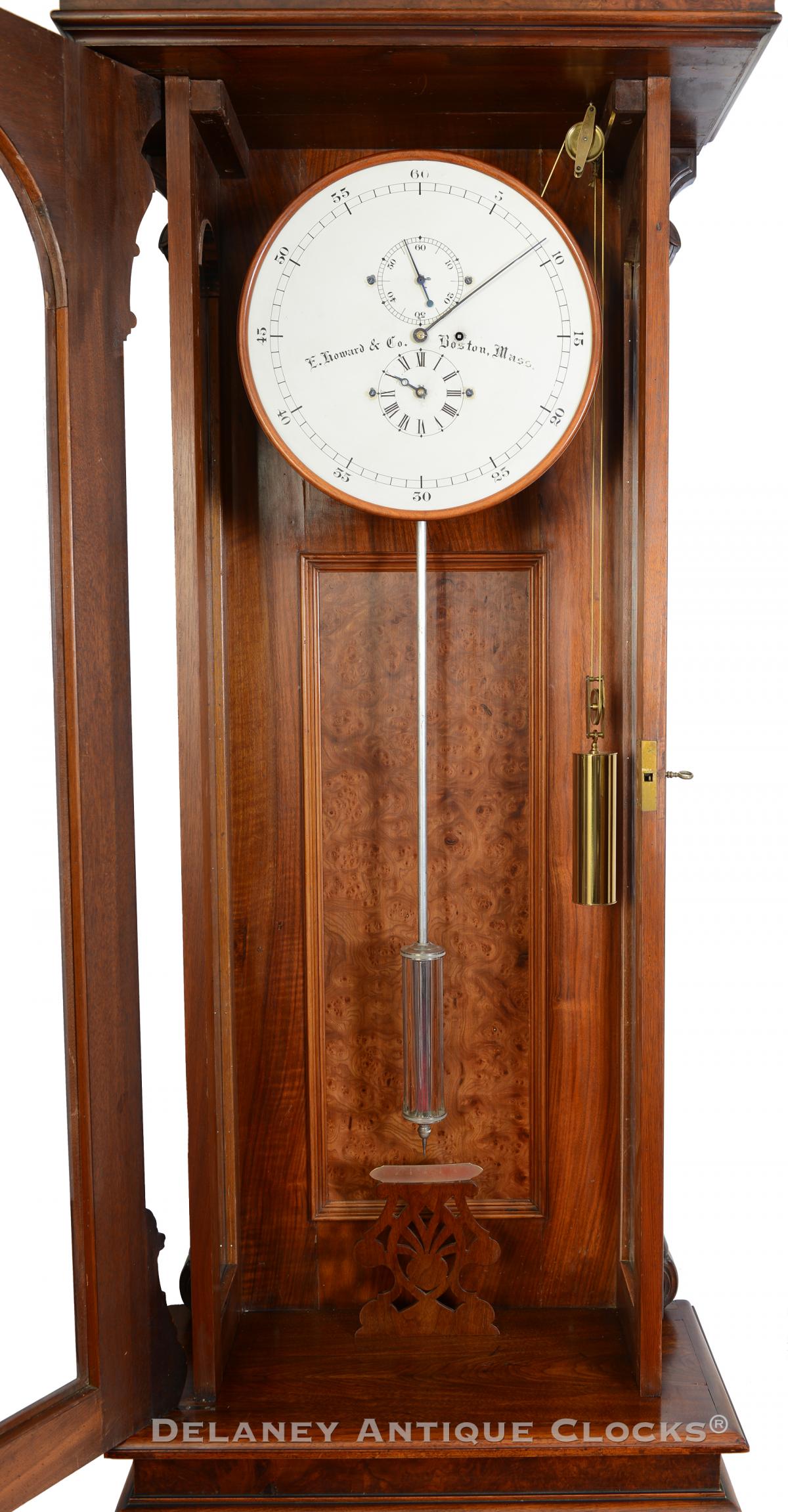E. Howard Model No. 67 Astronomical Wall Regulator Clock. Made in Boston, Massachusetts, circa 1894. 223033.
The E. Howard & Company of Boston, Massachusetts, made this very impressive wall regulator. This regulator is cataloged as the Model Number 67 and is constructed in black walnut. The color and tones are exemplary.
Like most big Howard-made regulators, this outstanding example is a challenging model to locate. Very few large Howard clocks come onto the public marketplace. And when they do, they are eagerly sought out by a number of enthusiastic collectors. This model was built in 1894 and would have originally sold for approximately $250.
This model 67 case is constructed in black walnut. It features outstanding, figured burl walnut veneered panels and numerous carved decorations. The most prominent carved feature is mounted to the center of the upper crest. It is in the form of a bull's head, complete with horns. The head overlooks the room where this massive regulator is hung. Howard also made this model with the likeness of Jenny Lind or a deer head complete with antlers in this location. One example was special-ordered with the head of Christopher Columbus. Four turned and carved finials are mounted at the top of the case and positioned at each of the four corners. A fifth finial is mounted under the lower bracket at the bottom of the cabinet. All of the woodwork is in excellent condition.
The painted zinc dial measures approximately 16 inches in diameter. It is mounted directly to the movement with four screws that pass through the dial and thread into the dial standoffs. A walnut bezel is used to trim the perimeter of the dial. The painted front surface of the dial retains its original decoration. This dial displays the time in an astronomical dial format. The minutes are located along the perimeter of the dial sheet. Each of the five-minute markers is indicated in the appropriate Arabic numeral. The seconds and hour displays are enclosed within the minute ring. Each of the ten-second increments is marked with the corresponding Arabic numerals. The hour display is positioned below the second's dial. Each hour is represented in a Roman-style hour numeral. The Maker's name is signed across the middle of the dial in large block lettering.
The heavily brass-constructed eight-day weight-powered movement measures approximately 9.5 inches tall, 6.5 inches wide, and 2.25 inches deep. These plates retain their original decorative scraping design. This movement, a number "3," features a Graham dead-beat escapement, maintaining power, and a complete Geneva Stop winding mechanism. The front plate is die-stamped "E. Howard & Co. Boston." The inside of the great wheel is engraved, "Set up 5 – 1894 – L. P. Emmerson." The wooden rod pendulum supports a glass jar. This glass jar is made with multiple glass rods fused in a column. Decorative steel caps are located at both ends. At the bottom of the rod is the rating nut. At the top of the crutch, one will find the fine beat adjustment device. This example retains the correct brass pulley with a five-spoke wheel and winding key.
According to the E. Howard clock records. This clock was initially ordered by the American Tabacco Company through the New York Office on April 20, 1894, and set up approximately a month later on May 26. It was to be shipped to M.K. Jones / Durham, NC.
This hanging case is 8 feet 9 inches long, 34.5 inches wide, and 12 inches deep.
Inventory number 223033.
The E. Howard & Company succeeded the Howard & Davis firm in 1857. The Howard & Davis firm was comprised of Edward Howard and David Porter Davis and was established in 1842 in Roxbury, Massachusetts. Both men had just completed their clock apprenticeship under the guidance of Aaron Willard Jr in Boston. The Howard & Davis firm made high-grade clocks, precision balances, sewing machines, fire engines, and watches. After the dissolution of Howard & Davis, Edward Howard became Boston's leading manufacturer of weight-driven residential and commercial clocks. The firm also made a large number of tower clocks and watchman and salve clock systems. These sold well in the last quarter of the 1800s.
It has been said that the E. Howard Clock company never made an inexpensive clock, and everything they made was of very good quality. As a result, Howard clocks have become very collectible and are prized by their owners. Today, the E. Howard name enjoys outstanding name recognition.
For a more in-depth reading of Edward Howard and his various businesses, please read "Willard's Patent Time Pieces," written by Paul Foley.




















